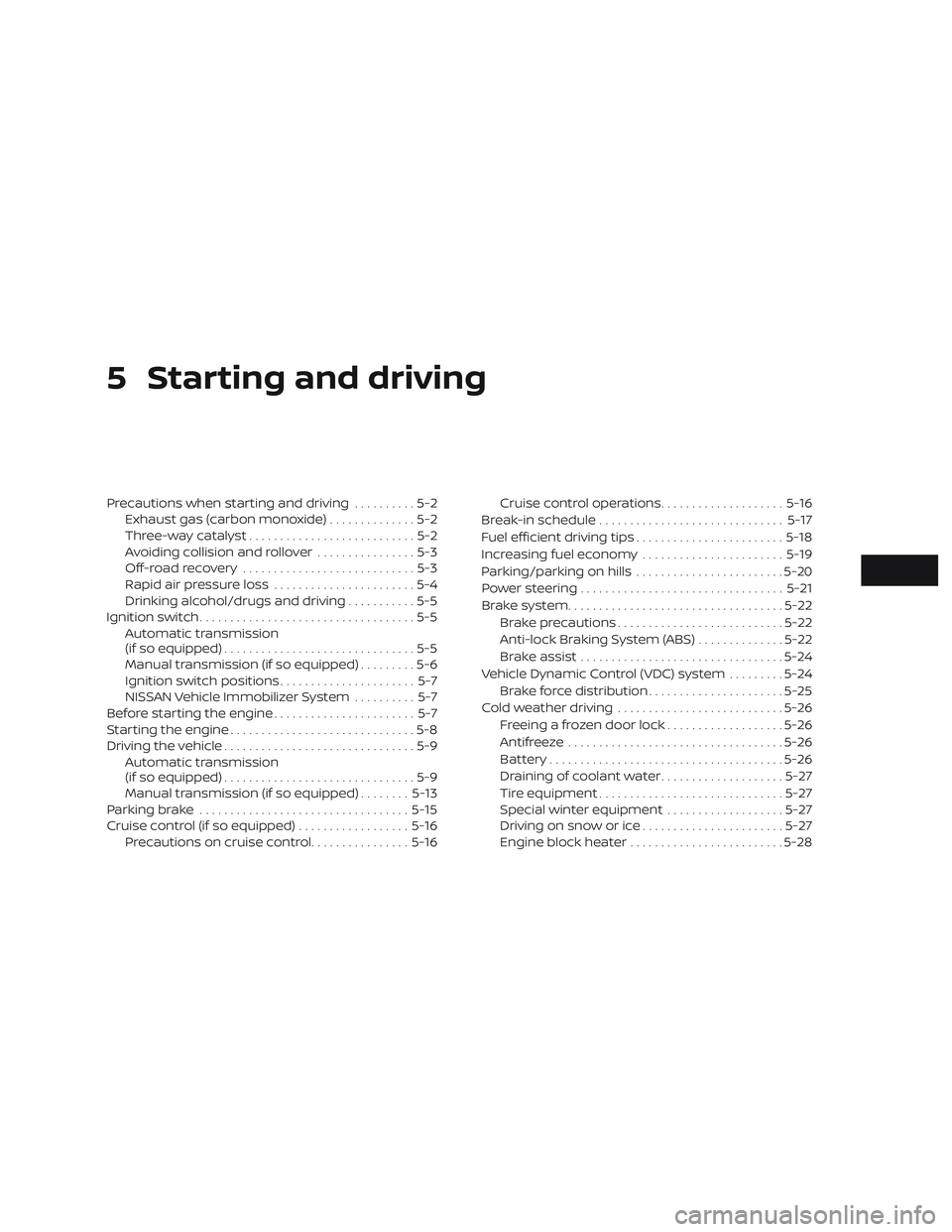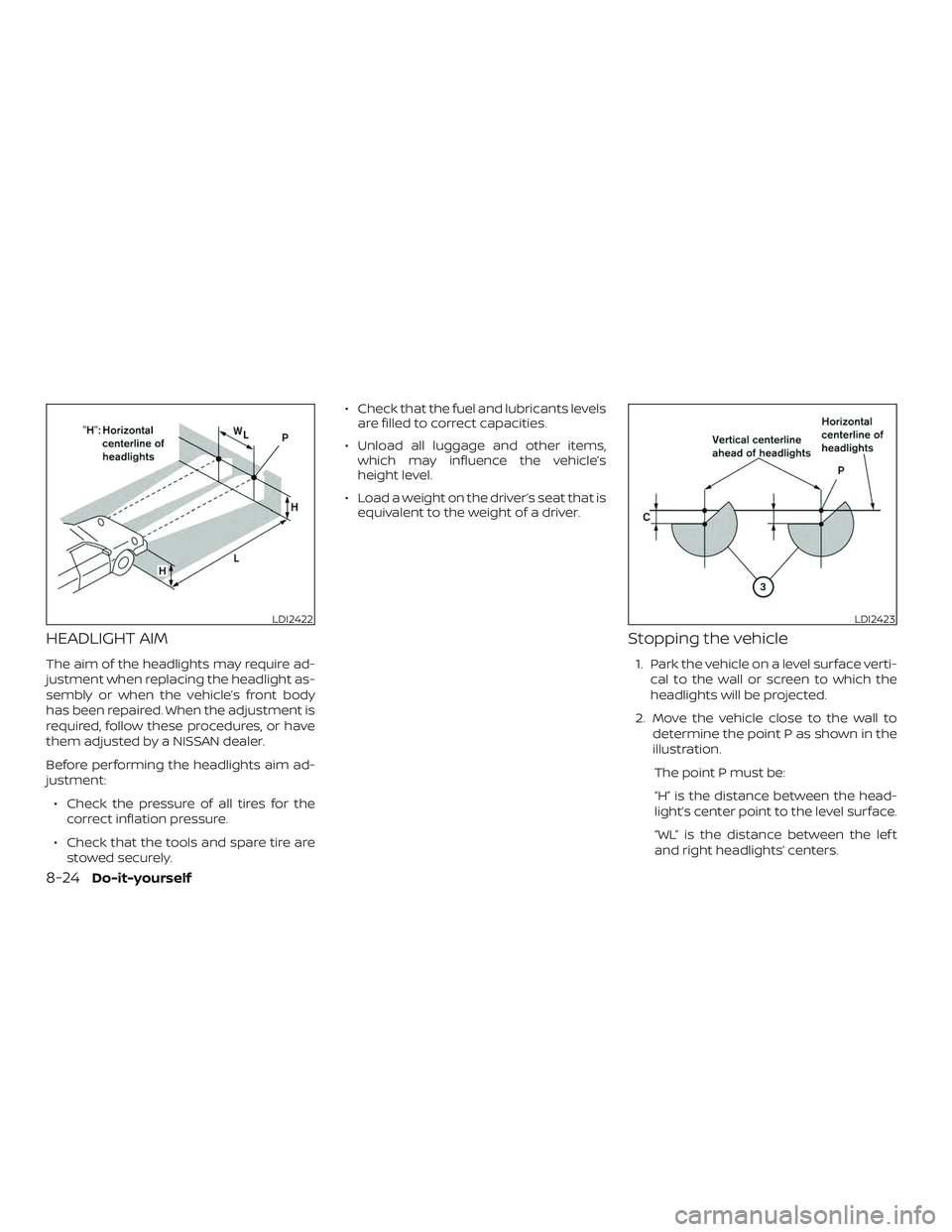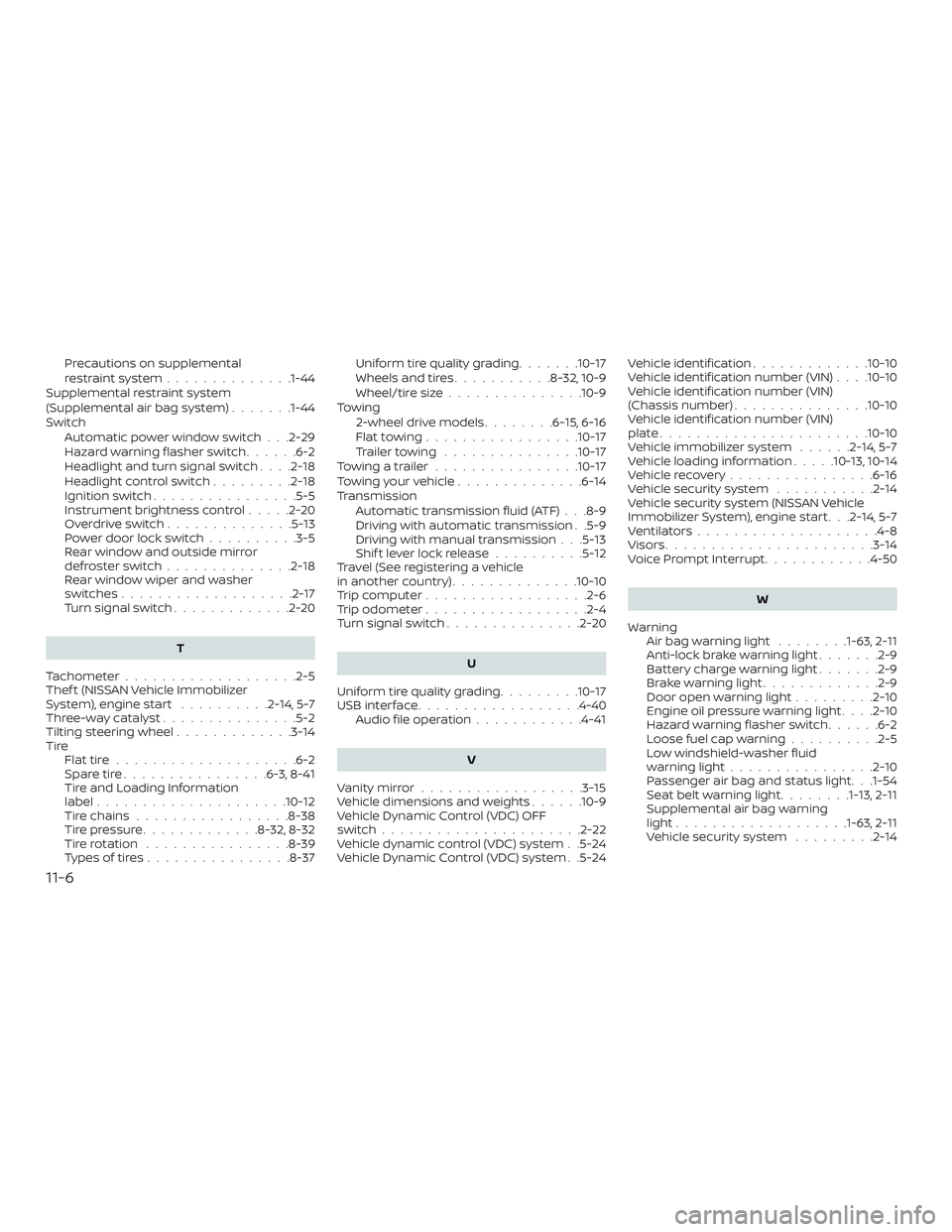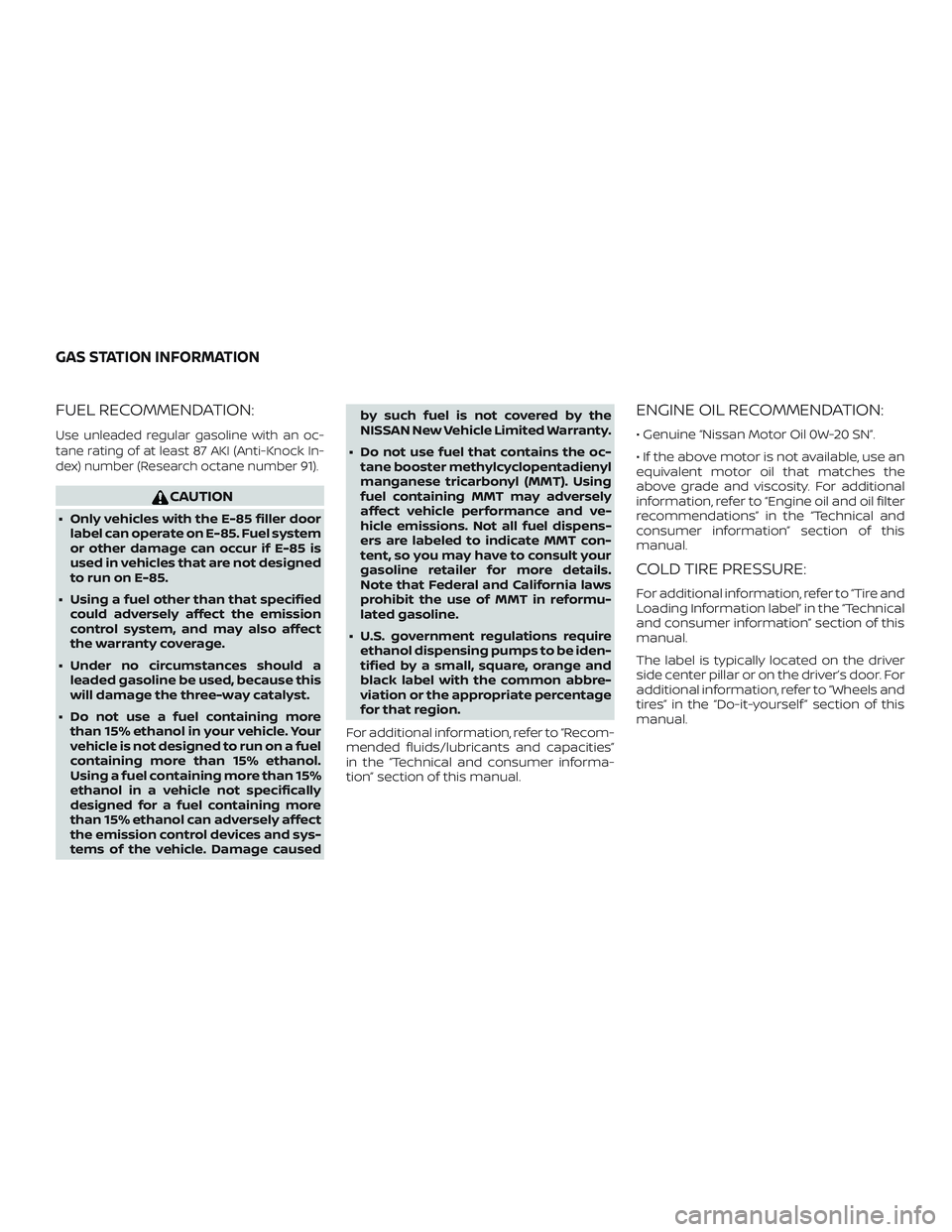2018 NISSAN MICRA fuel pressure
[x] Cancel search: fuel pressurePage 136 of 330

∙ Objects viewed in the RearView Moni-tor differ from actual distance be-
cause a wide-angle lens is used.
∙ Objects in the RearView Monitor will appear visually opposite compared to
when viewed in the rearview and out-
side mirrors.
∙ Use the displayed lines as a reference. The lines are highly affected by the
number of occupants, fuel level, ve-
hicle position, road conditions and
road grade.
∙ Make sure that the rear hatch is se- curely closed when backing up.
∙ Do not put anything on the rearview camera. The rearview camera is in-
stalled above the license plate.
∙ When washing the vehicle with high pressure water, be sure not to spray it
around the camera. Otherwise, water
may enter the camera unit causing
water condensation on the lens, a
malfunction, fire or an electric shock.
∙ Do not strike the camera. It is a preci- sion instrument. Otherwise, it may
malfunction or cause damage result-
ing in a fire or an electric shock. The following are operating limitations and
do not represent a system malfunction:
∙ When the temperature is extremely high or low, the screen may not clearly
display objects.
∙ When strong light directly shines on the camera, objects may not be displayed
clearly.
∙ Vertical lines may be seen in objects on the screen. This is due to strong re-
flected light from the bumper.
∙ The screen may flicker under fluores- cent light.
∙ The colors of objects on the RearView Monitor may differ somewhat from the
actual color of objects.
∙ Objects on the monitor may not be clear in a dark environment.
∙ There may be a delay when switching between views.
∙ If dirt, rain or snow accumulate on the camera, RearView Monitor may not dis-
play objects clearly. Clean the camera. ∙ Do not use wax on the camera lens.
Wipe off any wax with a clean cloth
dampened with a diluted mild cleaning
agent, then wipe with a dry cloth.
Heater, air conditioner, audio and phone systems4-7
Page 188 of 330

5 Starting and driving
Precautions when starting and driving..........5-2
Exhaust gas (carbon monoxide) ..............5-2
Three-way catalyst ...........................5-2
Avoiding collision and rollover ................5-3
Off-roadrecovery ............................5-3
Rapid air pressure loss .......................5-4
Drinking alcohol/drugs and driving ...........5-5
Ignition switch ...................................5-5
Automatic transmission
(if so equipped) ...............................5-5
Manual transmission (if so equipped) .........5-6
Ignition switch positions ......................5-7
NISSAN Vehicle Immobilizer System ..........5-7
Before starting the engine .......................5-7
Starting the engine ..............................5-8
Driving the vehicle ...............................5-9
Automatic transmission
(if so equipped) ...............................5-9
Manual transmission (if so equipped) ........5-13
Parking brake .................................. 5-15
Cruise control (if so equipped) ..................5-16
Precautions on cruise control ................5-16Cruise control operations
....................5-16
Break-in schedule .............................. 5-17
Fuel efficient driving tips ........................5-18
Increasing fuel economy .......................5-19
Parking/parking on hills ........................5-20
Power steering ................................. 5-21
Brake system ................................... 5-22
Brake precautions ........................... 5-22
Anti-lock Braking System (ABS) ..............5-22
Brake assist ................................. 5-24
Vehicle Dynamic Control (VDC) system .........5-24
Brake force distribution ......................5-25
Cold weather driving ........................... 5-26
Freeing a frozen door lock ...................5-26
Antifreeze ................................... 5-26
Battery...................................... 5-26
Draining of coolant water ....................5-27
Tire equipment .............................. 5-27
Special winter equipment ...................5-27
Driving on snow or ice .......................5-27
Engine block
heater ......................... 5-28
Page 206 of 330

9.Winter Warm Up
∙ Limit idling time to minimize impact to fuel economy.
∙ Vehicles typically need no more than 30 seconds of idling at start-up to
effectively circulate the engine oil be-
fore driving.
∙ Your vehicle will reach its ideal oper- ating temperature more quickly
while driving versus idling.
10. Keeping your Vehicle Cool
∙ Park your vehicle in a covered parking area or in the shade whenever pos-
sible.
∙ When entering a hot vehicle, opening the windows will help to reduce the
inside temperature faster, resulting in
reduced demand on your A/C sys-
tem. The following methods are recommended
by NISSAN to increase fuel economy on
NISSAN vehicles. All these recommenda-
tions can help you to achieve a higher level
of fuel economy in your vehicle.
∙ Accelerate slowly and smoothly. Main- tain cruising speeds with a constant ac-
celerator position.
∙ Drive at moderate speeds on the high- way. Driving at high speed lowers fuel
economy.
∙ Avoid unnecessary stopping and brak- ing. Maintain a safe distance behind
other vehicles.
∙ Use a proper gear range which suits road conditions. On level roads, shif t
into high gear as soon as possible.
∙ Avoid unnecessary engine idling.
∙ Keep your engine tuned up.
∙ Follow the recommended scheduled maintenance.
∙ Keep the tires inflated to the correct pressure. Low tire pressure increases
tire wear and lowers fuel economy. ∙ Keep the wheels in correct alignment.
Improper alignment increases tire wear
and lowers fuel economy.
∙ Air conditioner operation lowers fuel economy. Use the air conditioner only
when necessary.
∙ When cruising at highway speeds, it is more economical to use the air condi-
tioner and leave the windows closed to
reduce drag.
∙ Use the recommended viscosity engine oil. For additional information, refer to
“Engine oil and oil filter recommenda-
tions” in the “Technical and consumer
information” section of this manual.
INCREASING FUEL ECONOMY
Starting and driving5-19
Page 243 of 330

When performing any inspection or main-
tenance work on your vehicle, always take
care to prevent serious accidental injury to
yourself or damage to the vehicle. The fol-
lowing are general precautions which
should be closely observed.
WARNING
∙ Park the vehicle on a level surface, ap-ply the parking brake securely and
block the wheels to prevent the ve-
hicle from moving. For manual trans-
mission models, move the shif t lever
to N (Neutral). For Automatic Trans-
mission (A/T) move the shif t lever to P
(Park)
∙ Be sure the ignition key is in the OFF or LOCK position when performing any
parts replacement or repairs.
∙ Your vehicle is equipped with an auto- matic engine cooling fan. It may come
on at any time without warning, even
if the ignition key is in the OFF position
and the engine is not running. To
avoid injury, always disconnect the
negative battery cable before work-
ing near the fan. ∙ If you must work with the engine run-
ning, keep your hands, clothing, hair
and tools away from moving fans,
belts and any other moving parts.
∙ It is advisable to secure or remove any loose clothing and remove any jew-
elry, such as rings, watches, etc. be-
fore working on your vehicle.
∙ Always wear eye protection whenever you work on your vehicle.
∙ If you must run the engine in an en- closed space such as a garage, be sure
there is proper ventilation for exhaust
gases to escape.
∙ Never get under the vehicle while it is supported only by a jack. If it is neces-
sary to work under the vehicle, sup-
port it with safety stands.
∙ Keep smoking materials, flame and sparks away from the fuel tank and
battery.
∙ On gasoline engine models, the fuel filter or fuel lines should be serviced
because the fuel lines are under high
pressure even when the engine is off.
It is recommended that you visit a
NISSAN dealer for this service.
CAUTION
∙ Do not work under the hood while theengine is hot. Turn the engine off and
wait until it cools down.
∙ Avoid contact with used engine oil and coolant. Improperly disposed en-
gine oil, engine coolant and/or other
vehicle fluids can damage the envi-
ronment. Always conform to local
regulations for disposal of vehicle
fluid.
∙ Never leave the engine or automatic transmission related component har-
nesses disconnected while the igni-
tion switch is in the ON position.
∙ Never connect or disconnect the bat- tery or any transistorized component
while the ignition switch is in the ON
position.
This “Do-it-yourself ” section gives instruc-
tions regarding only those items which are
relatively easy for an owner to perform.
You should be aware that incomplete or
improper servicing may result in operating
difficulties or excessive emissions, and
could affect warranty coverage. If in doubt
about any servicing, it is recommended
that you have it done by a NISSAN dealer.
MAINTENANCE PRECAUTIONS
8-2Do-it-yourself
Page 265 of 330

HEADLIGHT AIM
The aim of the headlights may require ad-
justment when replacing the headlight as-
sembly or when the vehicle’s front body
has been repaired. When the adjustment is
required, follow these procedures, or have
them adjusted by a NISSAN dealer.
Before performing the headlights aim ad-
justment:∙ Check the pressure of all tires for the correct inflation pressure.
∙ Check that the tools and spare tire are stowed securely. ∙ Check that the fuel and lubricants levels
are filled to correct capacities.
∙ Unload all luggage and other items, which may influence the vehicle’s
height level.
∙ Load a weight on the driver’s seat that is equivalent to the weight of a driver.
Stopping the vehicle
1. Park the vehicle on a level surface verti-
cal to the wall or screen to which the
headlights will be projected.
2. Move the vehicle close to the wall to determine the point P as shown in the
illustration.
The point P must be:
“H” is the distance between the head-
light’s center point to the level surface.
“WL” is the distance between the lef t
and right headlights’ centers.
LDI2422LDI2423
8-24Do-it-yourself
Page 321 of 330

CD player (See audio system)....4-34,4-39
Childrestraints........1-20, 1-21, 1-23, 1-25 LATCH (Lower Anchors and Tethers
forCHildren)System ...........1-25
Precautions on child
restraints .........1-23, 1-30, 1-36, 1-41
Top tether strap anchor point
locations.................. .1-28
Child safety rear door lock ..........3-6
Chimes, audible reminders .........2-14
Cleaningexteriorandinterior......7-2,7-4
Clockset.................4-33,4-38
Clutch Clutchfluid.................8-10
C.M.V.S.S. certification label .........10-11
Coldweatherdriving.............5-26
Compact disc (CD) player .......4-34,4-39
Controls Audio controls (steering wheel) ....4-45
Heater and air conditioner controls . .4-15
Coolant Capacities and recommended
fuel/lubricants...............10-2
Changing engine coolant .........8-5
Checking engine coolant level ......8-5
Corrosionprotection..............7-7
Cruisecontrol..................5-16
Cupholders...............2-24,2-25
Curtain side-impact and rollover
airbag......................1-60
D
Daytime light system .............2-19 Defroster switch
Rear window and outside mirror
defrosterswitch..............2-18
Dimensions and weights ...........10-9
Dimmer switch for instrument panel . . .2-20
Door locks ..................3-3,3-4
Door open warning light ...........2-10
Drivebelt ....................8-14
Driving Cold weather driving ...........5-26
Driving with automatic transmission . .5-9
Driving with manual transmission . . .5-13
Precautions when starting and
driving.....................5-2
Drivingthevehicle ...............5-9
E
Economy - fuel .................5-19
Emission control information label . . . .10-11
Emission control system warranty . . . .10-18
Engine Before starting the engine ........5-7
Blockheater................5-28
Capacities and recommended
fuel/lubricants...............10-2
Changing engine coolant .........8-5
Changing engine oil ............8-7
Changing engine oil filter .........8-8
Checking engine coolant level ......8-5
Checking engine oil level .........8-6
Engine compartment check
locations...................8-3
Engine cooling system ..........8-4
Engine oil ...................8-6 Engine oil and oil filter
recommendation
.............10-6
Engine oil pressure warning light . . . .2-10
Engine oil viscosity .............10-6
Engine serial number ...........10-11
Engine specifications ...........10-8
Starting the engine .............5-8
EventDatarecorders............10-20
Exhaust gas (Carbon monoxide) .......5-2
Explanation of maintenance items .....9-2
Explanation of scheduled maintenance
items .......................9-5
Extended storage switch ..........8-20
F
Flashers (See hazard
warningflasherswitch)............6-2
Flattire......................6-2
Floormatpositioningaid...........7-6
Fluid Automatic transmission fluid (ATF) . . .8-9
Brakefluid..................8-9
Capacities and recommended
fuel/lubricants...............10-2
Clutchfluid.................8-10
Engine coolant ...............8-4
Engine oil ...................8-6
Front air bag system (See
supplemental restraint system) ......1-54
Front-door pocket ...............
2
-23
Frontseats....................1-2
Fuel Capacities and recommended
fuel/lubricants...............10-2
11-2
Page 325 of 330

Precautions on supplemental
restraint system..............1-44
Supplemental restraint system
(Supplemental air bag system) .......1-44
Switch Automatic power window switch . . .2-29
Hazard warning flasher switch ......6-2
Headlight and turn signal switch ....2-18
Headlightcontrolswitch.........2-18
Ignition switch ................5-5
Instrument brightness control .....2-20
Overdriveswitch..............5-13
Power door lock switch ..........3-5
Rear window and outside mirror
defrosterswitch..............2-18
Rear window wiper and washer
switches ...................2-17
Turn signal switch .............2-20
T
Tachometer ...................2-5
Thef t (NISSAN Vehicle Immobilizer
System), engine start ..........2-14,5-7
Three-waycatalyst...............5-2
Tilting steering wheel .............3-14
Tire Flattire....................6-2
Spare tire ................6-3,8-41
Tire and Loading Information
label .....................10-12
Tire chains .................8-38
Tire pressure .............8-32,8-32
Tirerotation ................8-39
Types of tires ................8-37 Uniform tire quality grading
.......10-17
Wheels and tires ...........8-32,10-9
Wheel/tire size ...............10-9
Towing 2-wheel drive models ........6-15,6-16
Flattowing.................10-17
Trailertowing ...............10-17
Towingatrailer................10-17
Towingyourvehicle..............6-14
Transmission Automatic transmission fluid (ATF) . . .8-9
Driving with automatic transmission . .5-9
Driving with manual transmission . . .5-13
Shiftleverlockrelease..........5-12
Travel (See registering a vehicle
in another country) ..............10-10
Trip computer ..................2-6
Trip odometer ..................2-4
Turn signal switch ...............2-20
U
Uniform tire quality grading .........10-17
USBinterface..................4-40 Audio file operation ............4-41
V
Vanitymirror..................3-15
Vehicle dimensions and weights ......10-9
Vehicle Dynamic Control (VDC) OFF
switch......................2-22
Vehicle dynamic control (VDC) system . .5-24
Vehicle Dynamic Control (VDC) system . .5-24 Vehicle identification
.............10-10
Vehicle identification number (VIN) . . . .10-10
Vehicle identification number (VIN)
(Chassis number) ...............10-10
Vehicle identification number (VIN)
plate.......................10-10
Vehicle immobilizer system ......2-14,5-7
Vehicle loading information .....10-13,10-14
Vehiclerecovery................6-16
Vehicle security system ...........2-14
Vehicle security system (NISSAN Vehicle
Immobilizer System), engine start . . .2-14, 5-7
Ventilators ....................4-8
Visors.......................3-14
Voice Prompt Interrupt ............4-50
W
Warning Airbagwarninglight ........1-63, 2-11
Anti-lock brake warning light .......2-9
Battery charge warning light .......2-9
Brakewarninglight.............2-9
Door open warning light .........2-10
Engine oil pressure warning light . . . .2-10
Hazard warning flasher switch ......6-2
L o
osefuelcapwarning..........2-5
Low windshield-washer fluid
warninglight............... .2-10
Passenger air bag and status light. . .1-54
Seatbeltwarninglight........1-13, 2-11
Supplemental air bag warning
light.................. .1-63, 2-11
Vehicle security system .........2-14
11-6
Page 328 of 330

FUEL RECOMMENDATION:
Use unleaded regular gasoline with an oc-
tane rating of at least 87 AKI (Anti-Knock In-
dex) number (Research octane number 91).
CAUTION
∙ Only vehicles with the E-85 filler doorlabel can operate on E-85. Fuel system
or other damage can occur if E-85 is
used in vehicles that are not designed
to run on E-85.
∙ Using a fuel other than that specified could adversely affect the emission
control system, and may also affect
the warranty coverage.
∙ Under no circumstances should a leaded gasoline be used, because this
will damage the three-way catalyst.
∙ Do not use a fuel containing more than 15% ethanol in your vehicle. Your
vehicle is not designed to run on a fuel
containing more than 15% ethanol.
Using a fuel containing more than 15%
ethanol in a vehicle not specifically
designed for a fuel containing more
than 15% ethanol can adversely affect
the emission control devices and sys-
tems of the vehicle. Damage caused by such fuel is not covered by the
NISSAN New Vehicle Limited Warranty.
∙ Do not use fuel that contains the oc- tane booster methylcyclopentadienyl
manganese tricarbonyl (MMT). Using
fuel containing MMT may adversely
affect vehicle performance and ve-
hicle emissions. Not all fuel dispens-
ers are labeled to indicate MMT con-
tent, so you may have to consult your
gasoline retailer for more details.
Note that Federal and California laws
prohibit the use of MMT in reformu-
lated gasoline.
∙ U.S. government regulations require ethanol dispensing pumps to be iden-
tified by a small, square, orange and
black label with the common abbre-
viation or the appropriate percentage
for that region.
For additional information, refer to “Recom-
mended fluids/lubricants and capacities”
in the “Technical and consumer informa-
tion” section of this manual.
ENGINE OIL RECOMMENDATION:
• Genuine “Nissan Motor Oil 0W-20 SN”.
• If the above motor is not available, use an
equivalent motor oil that matches the
above grade and viscosity. For additional
information, refer to “Engine oil and oil filter
recommendations” in the “Technical and
consumer information” section of this
manual.
COLD TIRE PRESSURE:
For additional information, refer to “Tire and
Loading Information label” in the “Technical
and consumer information” section of this
manual.
The label is typically located on the driver
side center pillar or on the driver’s door. For
additional information, refer to “Wheels and
tires” in the “Do-it-yourself ” section of this
manual.
GAS STATION INFORMATION